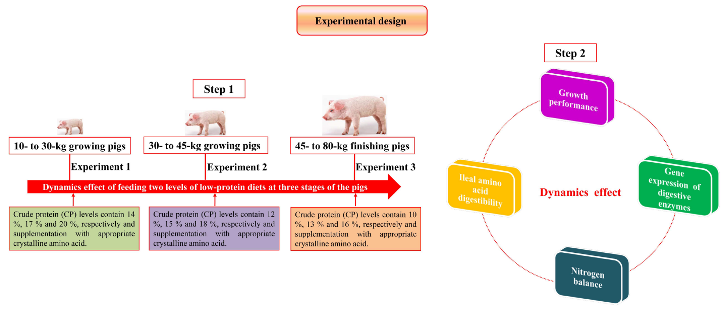This study was conducted to determine the dynamic effects of dietary crude protein (CP) intake on nitrogen (N) balance, ileal amino acid digestibility, and gene expression levels of digestive enzymes at three stages in pigs. In Experiment 1, 18 growing pigs (average body weight (BW) = 9.5 kg) were randomly assigned to one of three treatments (n = 6/treatment group), including normal (20% CP), low (17% CP), and very low (14% CP) protein intake. In Experiment 2, 18 growing pigs (average BW = 30 kg) were allotted randomly to one of three treatments (n = 6/treatment group), including normal (18% CP), low (15% CP), and very low (12% CP) protein intake. In Experiment 3, 18 growing pigs (average BW = 45 kg) were assigned randomly to one of three treatments (n = 6/treatment group), including normal (16% CP), low (13% CP), and very low (10% CP) protein intake. Growing pigs fed the 14% CP and 17% CP diets had lower final BW (P < 0.05) and average daily gain (ADG) (P < 0.05) compared to pigs fed the 20% CP diet. Reducing the dietary CP level from 20 to 14% decreased urinary N excretion by 52.8% (P < 0.001) in Experiment 1. Reducing the dietary CP level from 18 to 12% decreased urinary N excretion by 55.3% (P < 0.001) and reduced fecal N excretion by 34% (P < 0.05) in Experiment 2. Reducing the dietary CP level from 16 to 10% decreased urinary N excretion by 56.4% (P < 0.001) and fecal N excretion by 47.1% (P < 0.001) in Experiment 3. Pigs fed the very low (14%, 12%, and 10% CP) diets showed higher digestibility for CP (P < 0.05), His (P < 0.05), Ile (P < 0.05), Phe (P < 0.05), Thr (P < 0.05), Trp (P < 0.05), Glu (P < 0.05), and Ser (P < 0.05) compared to pigs fed the normal (20%, 18%, and 16% CP) diets among the three experiments. Pigs fed the very low (14%, 12%, and 10% CP) diets showed higher mRNA levels for chymotrypsin C (P < 0.01 in Experiment 1 and 2; P < 0.05 in Experiment 3) compared to pigs fed the normal (20%, 18%, and 16% CP) diets among the three experiments. These results indicated that a reduction in dietary CP by 6% limited the growth performance of growing pigs, and a reduction of dietary CP by 3% supplemented with essential amino acids could reduce the excretion of N into the environment without affecting weight gain.

